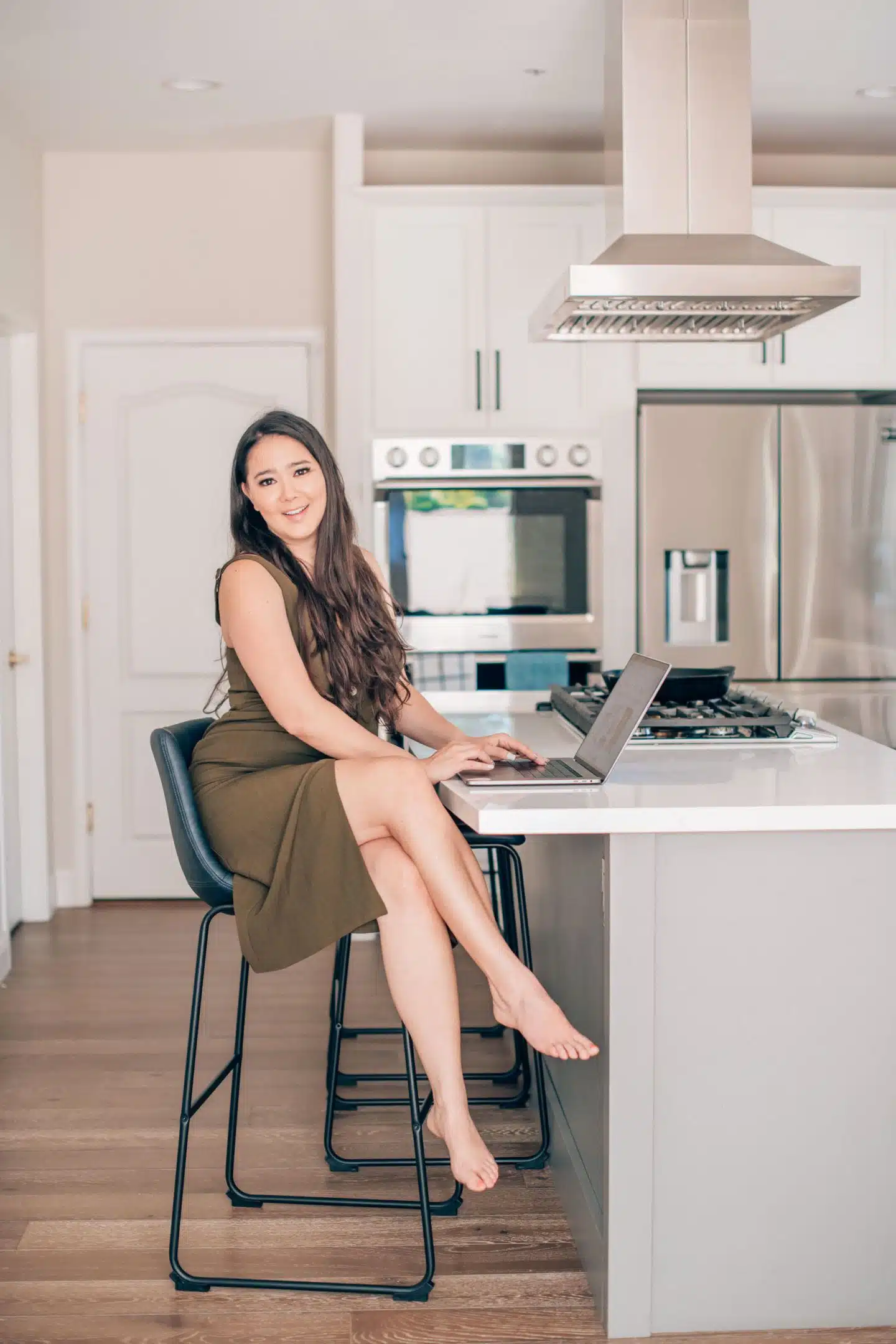
I’m so glad you guys have been enjoying the new house content because that’s literally all I’ve got right now since we’re not traveling! There’s one topic that has come up a lot in my DMs lately and that is: How to save for a house while renting. So today I’m excited to get all into the nitty-gritty of how we were able to save money for a down payment to buy our first house! Please note, I’m not a financial advisor, these are just my tips and what worked personally for us!
I’m pumped to be sharing all of these deets in partnership with Mint! I’ve been using the Mint app for literally over a decade, and it’s been a key tool in my ability to save money and eventually buy our new home.
I first started using Mint back in 2009 when I was in grad school. I had my first big girl job as a TA and was making a stipend each quarter. After being a poor college student, it was exciting to be making money, even though it wasn’t a lot! I wanted to see how much I could potentially save after two years of grad school if I lived frugally and stuck to a budget. So I found the Mint app and put together budgets for all of my expenses. It was exciting to see how much I could realistically save each month and to be able to project that I could save X amount by the end of grad school.
Even though my lifestyle, jobs, and income have changed over the years, one thing that hasn’t changed is I still use Mint. It’s the easiest way to track my finances and budgeting, and I love that I can use the app on my phone or the desktop version on my laptop.
As first-time homebuyers, our goal was to put down as large of a down payment as we could to help make our monthly mortgage as low as possible. Understanding exact numbers of how a down payment affects your monthly mortgage is something that your real estate agent or mortgage lender can help you understand, but in general, you want to aim for at least a 20% down payment, because that means you won’t have to deal with Private Mortgage Insurance (PMI), which is an extra cost your lender adds to your monthly payment just in case you don’t make your loan payments.
6 tips: How to save for a house while renting
1. Set your down payment savings goal. First things first, you’ve gotta set your goals so you know where you’re headed, how long it’ll take to get there, and what you need to do/save each month so you can make it happen. Mint is amazing for this. You can set a goal like Buy a Home, Crush Credit Card Debt, Buy a Car, etc. or write in your own custom goal. From there you’ll be able to enter your goal amount and target date and you’ll be able to see how much you need to save per month to make that goal happen.
2. Set your monthly budget and track everything. Now that you understand what your goals are, start setting your budgets. Mint makes this super easy too. You can link up all of your credit cards and accounts so that your transactions all get pulled into the Mint app. From there, you can categorize all of your transactions. Mint helps with this and will automatically suggest categories for transactions, like Groceries, Restaurants, Gas & Fuel, etc. If this is your first time setting a budget, I’d recommend going through and doing this first so you can get a feel for what you’re currently spending on certain categories.
Some expenses will be fixed, and you won’t be able to cut down on them, like your rent, car insurance, or phone bill. Others will fluctuate slightly but be within a certain range, like utilities and gas. And then lastly, things like Shopping, Restaurants, Travel, or Alcohol and Bars are totally within your control. Get a feel for your current state of expenses, and then think about how it relates to your income. If you keep up with your current state of expenses vs income, will you meet your savings goal in time? Where you can cut back on expenses? Do you need to cut back a little or a lot in order to meet your goal?
Using Mint to do this type of budgeting exercise can be so illuminating. For example, we discovered that Omied was spending a lot on Lyfts to get to work (back when we weren’t all working from home), and that it would actually save us money if he got a garage parking spot near his office.
3. Live within your means. Whether you’re in the home buying market or not, this is such an important savings tip. When my dad took me to the bank when I was 16 to get my very first credit card, he told me there was one golden rule I had to follow: Never spend more than I can afford, and always pay off the total amount on my credit card bill. I’ve taken that to heart and applied that rule to so many areas of my life that have to do with money. I don’t lease cars or have payment plans—I only buy what I can afford. Right now that means I drive my grandma’s 2001 Camry, and as we’re starting to look for a second car, we’re only looking at cars we can afford to flat out buy, rather than have a payment plan.
We rented the same one-bedroom apartment in the city for nine years. It was rent-controlled and in an awesome neighborhood. Especially over the last few years as our incomes increased but our apartment started to feel smaller and smaller (and older and older), we considered moving to a nicer, bigger place that we could still afford but of course would be more expensive. We ultimately decided to stick it out in our one-bedroom in order to save for a house while renting, and I’m so glad that we did. Let’s say a few years ago we had decided to move to a nicer apartment that was $1,000 more a month (SF is expensive, people). Over three years, that’s $36k that we saved in rent that instead went to our down payment for our house.
4. Get rid of any leases, loans, or debt. You’re not saving money if you’re in debt, so you’ve got to tackle this item first if you have any kind of debt. Omied had student loans that he was making monthly payments on, and once we were in a place financially where we could pay them off completely as a lump sum, we did so. Ideally, your goal should be to get to a place where you’re not paying an interest rate on anything. If you do have debt, use Mint’s Goals section to create a goal to pay it off.
5. Get a high-interest savings account. I wish I had a high-yield savings account sooner in life! Instead of having your savings sitting in a regular account that has a low-interest rate, check out options for savings accounts at higher rates. Mint actually has a section for suggested offers that you can peruse, and I’m currently seeing an offer for a 1% APY (annual percentage yield) with American Express. That’s a pretty good interest rate, considering an average savings account pays 0.10 percent APY, and it’s an easy way for your money to earn you more money!
6. Do a monthly deep dive into your finances. Lastly, I’d recommend doing a monthly deep dive into your spending. You can easily do this on the Mint app. I like to go through and make sure my transactions were all categorized correctly, and add a category to any miscellaneous ones. I’ll then take a look and make sure I’m staying within my budgets, and Mint makes it really easy to see a snapshot
The other thing that’s great about going through your transactions on the app is you will be able to see any subscriptions that are on auto-pay that you’ve forgotten about and don’t need anymore but are still getting charged for. You’d be surprised how often this happens! I have also caught errors this way, like an app that I had unsubscribed to but was still charging me.
There are so many other features that Mint offers, like finding personal loans, life insurance companies, keeping tabs on your credit score (also important when buying a house!), or finding more affordable auto insurance.
Get started saving with Mint today! It’s completely free to use, which is amazing. You can download the app here.
A huge thank you to Mint for sponsoring this post, and helping me save for my dream house!
Looking for more home content? You’ll find it here!

Elise Armitage is an entrepreneur and founder of What The Fab, a travel + lifestyle blog based in California. At the beginning of 2019, Elise left her corporate job at Google to chase her dreams: being an entrepreneur and helping women find fabulous in the everyday. Since then, she’s launched her SEO course Six-Figure SEO, where she teaches bloggers how to create a passive revenue stream from their website using SEO. Featured in publications like Forbes, Elle, HerMoney, and Real Simple, Elise is a firm believer that you can be of both substance and style.



